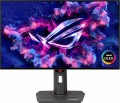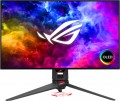Surface treatment
Modern monitors can use displays with both glossy and matte screen surfaces.
A matte surface is in some cases more preferable due to the fact that on a
glossy screen, when exposed to bright light, noticeable glare appears, sometimes interfering with viewing. On the other hand, glossy screens offer better picture quality, higher brightness, and richer colours.
Due to the development of technology,
monitors with a special anti-glare coating have appeared on the market, which, while maintaining all the advantages of a glossy screen, creates significantly less visible glare in bright ambient light.
Brightness
The maximum brightness provided by the monitor screen.
Choosing
a monitor with high brightness is especially important if the device is going to be used in bright ambient light — for example, if the workplace is exposed to sunlight. A dim image can be "dampened" by such lighting, making work uncomfortable. In other conditions, the high brightness of the screen is very tiring for the eyes.
Most modern monitors give out about 200 – 400 cd / m2 — this is usually quite enough even in the sun. However, there are also higher values: for example, in LCD panels (see "Type") the brightness can reach several thousand cd/m2. This is necessary taking into account the specifics of such devices — the image must be clearly visible from a long distance.
HDR
This technology is designed to expand the range of brightness reproduced by the monitor; Simply put, an HDR model will display brighter whites and darker blacks than a "regular" display. In fact, this means a significant improvement in colour quality. On the one hand, HDR provides a very "live" image, close to what the human eye sees, with an abundance of shades and tones that a normal screen cannot convey; on the other hand, this technology allows to achieve very bright and rich colours.
Modern HDR monitors may use the DisplayHDR designation. This standard takes into account a number of parameters that determine the overall quality of HDR performance: brightness, colour gamut, colour depth, etc. Based on the results of measurements, the monitor is assigned one of the following markings:
DisplayHDR 400 means relatively modest HDR capabilities,
DisplayHDR 600 is average,
DisplayHDR 1000 is above average,
DisplayHDR 1400 is advanced. At the same time, the absence of a DisplayHDR label in itself does not mean anything: it’s just that not every HDR monitor is tested according to this standard.
Note that for the full use of HDR, you need not only
the appropriate monitor, but also content (movies, television, etc.) originally created in HDR. In addition, there are several different HDR techn
...ologies that are not compatible with each other. Therefore, when buying a monitor with this function, it is highly desirable to clarify which version it supports.TÜV Rheinland certificate
Display certification for safe blue light emissions and panel flicker. The presence of a certificate confirms the comfort of the screen for the eyes.
TÜV Rheinland is a large international concern headquartered in Cologne, Germany, providing a wide range of audit services. The company's specialists have developed and approved a number of tests for the compliance of the screens of mobile devices, monitors and TVs with the required level of eye protection from the harmful effects of display radiation on the user's vision on the other side of the screen. The authoritative opinion of TÜV Rheinland is respected in the tech community. Certificates from this body are issued to successfully tested electronics for the implementation of blue light filtering and screen flicker suppression technologies.
Fast charge
Availability in the monitor USB port with function of
fast charging. This connector is used to charge batteries in various gadgets (smartphones, tablets, etc.). It differs from conventional USB ports in increased power supply; in addition, this connector may not support any other functions at all, except for charging.
Note that in modern technology various special technologies can be used to speed up the charging process. So before buying a monitor with this feature, it doesn't hurt to check if it supports any of these technologies and whether they will be compatible with devices that you plan to charge.
Power consumption
Rated power consumption of the monitor. Usually, this item indicates the maximum power that the device can consume during normal operation — that is, the energy consumption at maximum brightness, the highest volume of the built-in acoustics, etc. Actual power consumption can be noticeably lower, however, when choosing, it is still best to focus on the value stated in the specifications.
In general, the lower the power consumption, the more economical the device in terms of electricity consumption (ceteris paribus). In addition, this characteristic can be useful when selecting an uninterruptible power supply for a PC and in other specific situations when it is necessary to accurately determine the power consumption of equipment.

